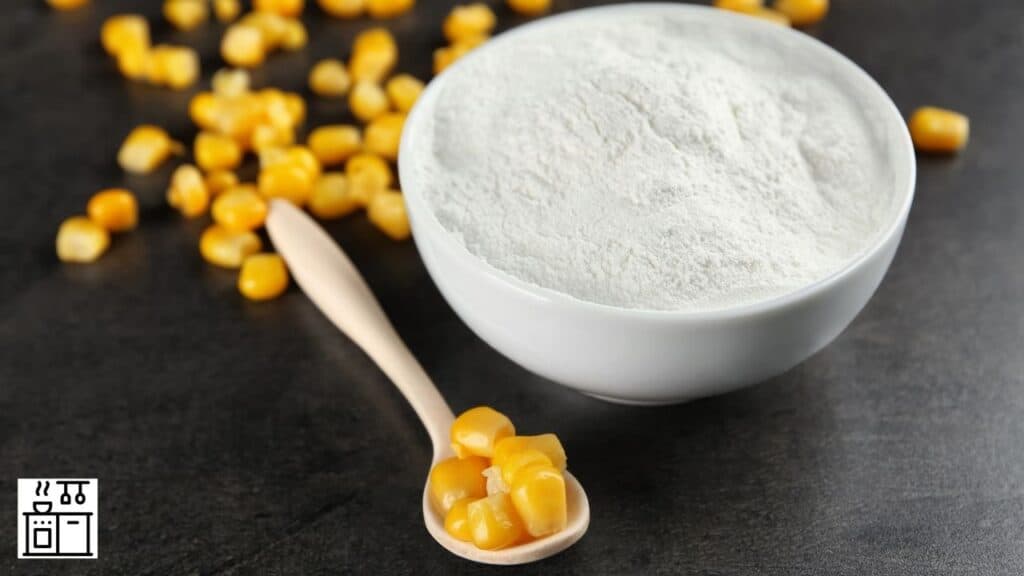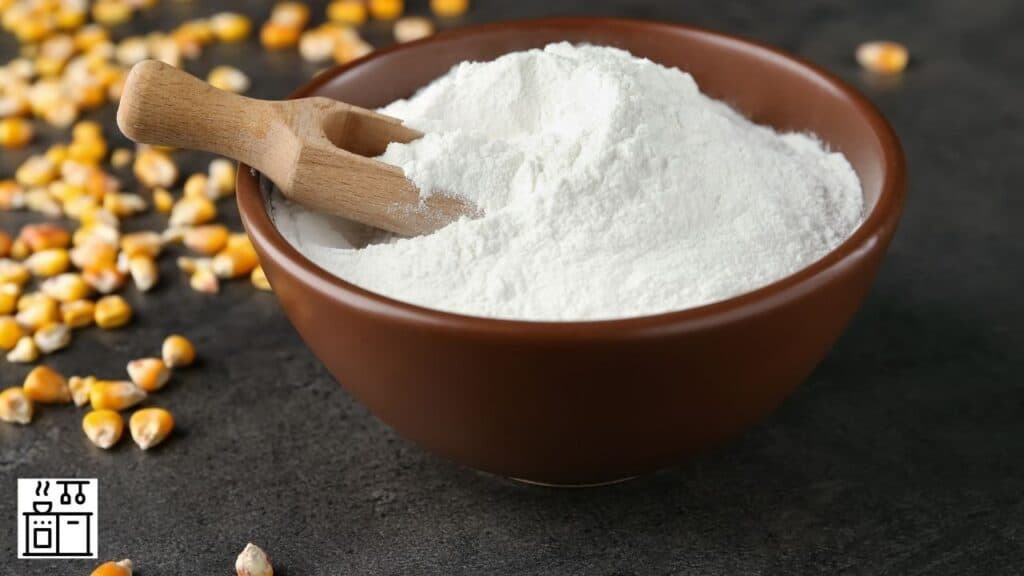Cornstarch is a versatile pantry ingredient used as a thickener for soups and gravy, as a baking ingredient, for batter-frying, and various other uses. So, how is cornstarch made?
Cornstarch is made using the starchy part of corn’s endosperm. For making cornstarch, the endosperm is first separated from the corn, soaked, and then the protein is separated from the starch. The remaining slurry is washed several times and dried to yield the white powder that we call cornstarch.
Let’s delve deeper into this now.
Cornflour Vs. Cornstarch
Corn is used to make two main powders—cornflour and cornstarch.
Corn flour uses whole corn kernels.
It’s yellow, has multiple nutritional benefits, and is widely used in cooking and baking.
Since it’s made using whole corn kernels, it has protein, fiber, vitamins, minerals, and all the nutrients of corn.
Now, the production of cornstarch involves an elaborate and detailed process because it uses only the endosperm of corn.
The endosperm is the starchy center of corn. It has no protein or fiber content.
To reach the endosperm, the outer husk and protein of corn are removed first.
This strips the corn of its fiber and protein content.
Hence, the nutritional quality of cornstarch is less than that of cornflour.
If we compare their taste, cornflour tastes like corn.
However, cornstarch lacks the distinct earthy, sweet taste of corn.
It’s white, devoid of nutrients, and mostly flavorless.
It’s mainly used to add texture to a dish and thicken it. It adds no flavor to a recipe.
Cornstarch is produced using a detailed and complex processing technique.
Let’s look at it in detail.
How Is Cornstarch Prepared?
All the nutritional qualities of corn are concentrated in the corn kernels.
This is the region beneath the outer husk.
The husk is a fibrous and tough material. It’s inedible and removed to consume the corn.
Once you get rid of the husk, you will be left with corn kernels that are embedded in a solid mass.
It’s what we call the germ.
The corn kernels contain the endosperm. It’s the starchy center of corn, which is used to make cornstarch.
To get to the endosperm, the outer layers of the kernel must be peeled off.
This is a time-consuming and elaborate process.
Now, not all corn is suitable for making cornstarch.
Corn that is more starchy than sweet is chosen for the purpose.
The procedure to extract cornstarch from it is as follows:
- The first step in the extraction process of cornstarch is removing corn kernels from the cob and soaking them. Soaking helps the grain soften and makes it easier to separate.
- Once the hull and germ have been separated, the endosperm is revealed. It has protein and starch in it. You only need the starchy bit to make cornstarch. So the next step is to separate the starch from the protein.
- A wet slurry is made by mixing the water and starch. The starch is washed several times until it’s pure. Finally, the remaining slurry is dried and milled into a fine powder. This is pure cornstarch. You can directly use it in your recipes.
Recommended: Does Cornstarch Dissolves In Water? | Can You Refrigerate Cornbread? | Is Kettle Corn Sweet?
4 Uses Of Cornstarch
Cornstarch in its pure form is a gritty white powder.
It doesn’t have any discernible taste or smell.
If you taste it in its raw form, you will find that it’s quite bland.
To use it in recipes, cornstarch is often mixed with a suitable liquid to form a watery mixture.
Here are the most common uses of this powder.
1. Thicken liquids like soups and gravies.
Cornstarch mixes well with liquids like water.
It becomes translucent when mixed with water, and you can use it as a thickening agent.
The basic procedure is to mix it with a liquid like water to prepare a slurry.
The liquid should be at room temperature for the cornstarch to dissolve properly.
You can also use liquids like wine or vegetable broth for mixing.
To thicken the dish, gently pour this mixture into the dish while it simmers on the stove.
Stir it in until it dissolves completely.
The starch molecules in the cornstarch will absorb liquid and swell up and gelatinize.
This change in texture causes soups and gravies to achieve a thicker consistency.
You can use cornstarch as a thickening agent for soups, stews, desserts, pie fillings, and various other dishes.
2. Substitute for egg in baked goods.

Cornstarch is widely used as a substitute for eggs in vegan baking.
You can mix it with water in the ratio of 1 spoon of cornstarch for every 3 spoons of water and use it instead of an egg in a recipe.
This substitution works in cookies, cakes, bread, and various other baked items.
3. Add more structure to desserts.
When you dissolve cornstarch in water, the starch molecules expand and gelatinize.
You can use this slurry to enhance the texture and structure of different desserts.
It works with all types of flours and dessert batters.
Adding cornstarch to a dessert makes it light and chewy.
You can also use it to thicken watery batters and make them the right consistency for baking.
4. Batter and coating for deep-fried food items.
Cornstarch can be used as a batter for deep-frying vegetables, meat, and other fillings.
You can also dissolve it with water and use the slurry as a binding agent instead of egg in deep-fried snack recipes.
What Is Modified Cornstarch?
You may sometimes come across the term “modified cornstarch” on the label.
So, how is it different from regular cornstarch? Let’s find out.
The term “modified” on the package usually indicates that an ingredient has undergone genetic modification.
It usually applies to hybrid plant or animal-based food items that have undergone hybridization or any other type of genetic change.
However, the term “modified” in modified cornstarch is different.
This term implies that the cornstarch has been altered in some way to make it more useful and extend its shelf-life.
The starch may be roasted, acid-treated, or treated with an agent like sodium or potassium hydroxide to alter its chemical properties.
In all cases, the starting product remains normal cornstarch.
So, modified cornstarch is cornstarch that is physically, chemically, or enzymatically altered to improve its usability and shelf-life.
It improves its suitability for various tasks and makes it useful for a longer time.
Modified cornstarch is a common ingredient in ready-to-cook foods like gravy packets, soup mixes, dessert packs, or meal mixes that you can whip up in mere minutes.
Related: Why Is A Rice Cooker So Expensive? | Why Does A Microwave Oven Heat Unevenly?
How Is Modified Cornstarch Made?
Normal cornstarch is a perishable commodity.
Although it serves a wide range of purposes, it doesn’t keep for too long.
So you may be unable to buy it in bulk and store it for longer.
Modified cornstarch is made using specific varieties of corn.
Depending on the end-use, corn varieties with more amylose content or amylopectin content may be chosen.
Waxy maize starch is generally used to produce modified cornstarch.
Modified cornstarch is further processed by subjecting it to various physical and chemical changes.
The resulting product is usually gluten-free and allergy-free.
It’s also better suited for specific needs. It’s commonly used as a stabilizer, thickening agent, or emulsifier.
In the case of physically altered modified cornstarch, the cornstarch is roasted or heat-treated to extend its lifespan.
For chemically altered modified cornstarch, the cornstarch is treated with acid or hydroxide agents to make it more useful for certain applications.
Acid treatment generally reduces the viscosity of starch.
The cornstarch may also be treated with an electric charge.
These actions will change the properties of the cornstarch and improve its consistency and overall use.

